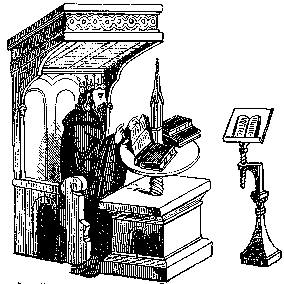
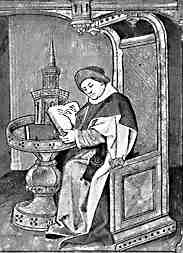

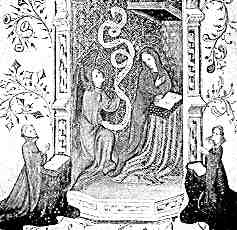
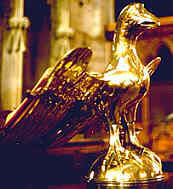
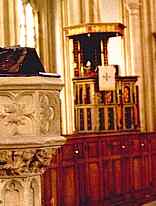
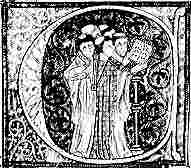

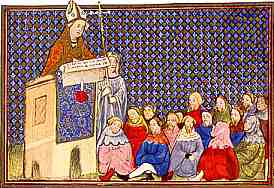
If you are looking at this page without frames, there is more information about medieval writing to be found by going to the home page (framed) or the site map (no frames).
| The Material Culture of Literacy (2) | |||||
 |
Reading, as well as writing, had its particular furnishings and material culture. I have absolutely no idea where the quaint image at left derives from, but our king, absentmindedly forgetting to remove his crown before going to the library for a quiet read, is equipped with two kinds of reading stands, as well as a splendidly throne-like reading chair. These objects repeatedly appear in actual medieval images. | ||||
| This image is captioned in the book where it is illustrated as "Guillaume de Lorris writing", but blind Freddy can see he is not writing. He doesn't have a pen for starters. Intriguingly, the caption goes on to note that medieval writers were not too fussy about resting their book on a flat surface, but images of scribes usually show them with a flat, if not horizontal surface. The elaborate circular piece of furniture is a reading desk, not a writing desk. Perhaps it is a point worth noting that a highly literate author of didactic poetry should be depicted reading with his finger running along the line of text. His library chair is as majestic and throne-like as that of the king depicted above. This is classy furniture for the library. |
 |
||||
| Depiction of Guillaume de Lorris, author of the first part of the Roman de la Rose, in a manuscript of that work (Bodleian Library). (From Lanson 1923) | |||||
 |
A similar circular reading stand appears in this 15th century miniature of an author reading. The library chairs certainly look more grand than comfortable. No snoozing in the library. | ||||
| The author Alain Chartier, as depicted in a 15th century manuscript of his work (Bibliothèque Nationale). (From Lanson 1923) | |||||
 |
Not all reading was done while lounging around in the library. Little prayer desks for kneeling were used for devotions such as reading from the Book of Hours. In the example at left, the actual piece of furniture appears to be covered with draperies and the soft wrappers used for covering the books when not they were open. | ||||
| Image of the Annunciation, with two elegant ladies at prayer desks (British Library, MS Roy. 2 A xviii). | |||||
| Within the context of the church, reading was not solely a private and silent affair. The written word was read aloud in company, and even sung. | |||||
 |
Books for the readings were probably quite large to accomodate a big, clear script, as the lighting in churches would have been a bit substandard. Lecterns such as the one illustrated at left were used to hold the books for the readings. This is a fairly rare medieval survival, as brass was useful over the centuries for various handy purposes, such as making cannons, so they periodically got knocked off. This one was recovered from the bottom of a lake. | ||||
| Medieval brass eagle lecturn in Southwell Minster, formerly from Newstead Abbey. | |||||
 |
The pulpit was an imposing object from which to declaim the word of God. This medieval example has been restored to the lavish colouring of the middle ages. Most people would have received their knowledge of the Bible from here rather than from the written text, supplemented by the visual imagery of the wall paintings and stained glass. | ||||
| Restored medieval pulpit, with font in the foreground, in the collegiate church of Fotheringhay in Northamptonshire. | |||||
 |
This historiated initial C, beginning the words Cantate domino, shows the clerics doing just that, singing to the Lord, with their book perched up in front of them on a lectern. The formal arrangements of the reading furniture within the space of the church provides a visual counterpoint to the formal aural arrangements of the reading and singing. | ||||
| Initial in the Luttrell Psalter (now in the British Library). (From New Palaeographical Society 1904) | |||||
 |
The choir stalls found in churches of significance, where the clergy sang the divine office, also included reading desks among their elaborate design. The lay public could hear the sacred words, but did not see the fine furniture, hidden as it was behind the choir screen in the holy inner sanctum. | ||||
| Choir stalls in Boston parish church, Lincolnshire. | |||||
| The clergy would have known the great part of their office by heart, but it was all from written texts, so we are looking at an intersection of oral and written culture here. | |||||
 |
Miniature of Archbishop Arundel preaching the cause of Henry Bolingbroke, in a French manuscript of the early 15th century (British Library, Harley 1319, f.12). (From an old postcard) | ||||
| Here, from the time of the struggle between Richard II and the future Henry IV, we have an image of an archbishop in full regalia, his pastoral cross displayed by his side, standing on a pulpit adorned with a rich cloth. Instead of reading from the Bible or some other sacred text, he is holding a large document with a big red seal attached. Was the artist representing this good churchman as appropriating the material symbols of authority of the church, including the elevated reading podium, to mere politics? Surely not! | |||||
|
|
|||||
|
|
|||||
|
If you are looking at this page without frames, there is more information about medieval writing to be found by going to the home page (framed) or the site map (no frames). |
|||||